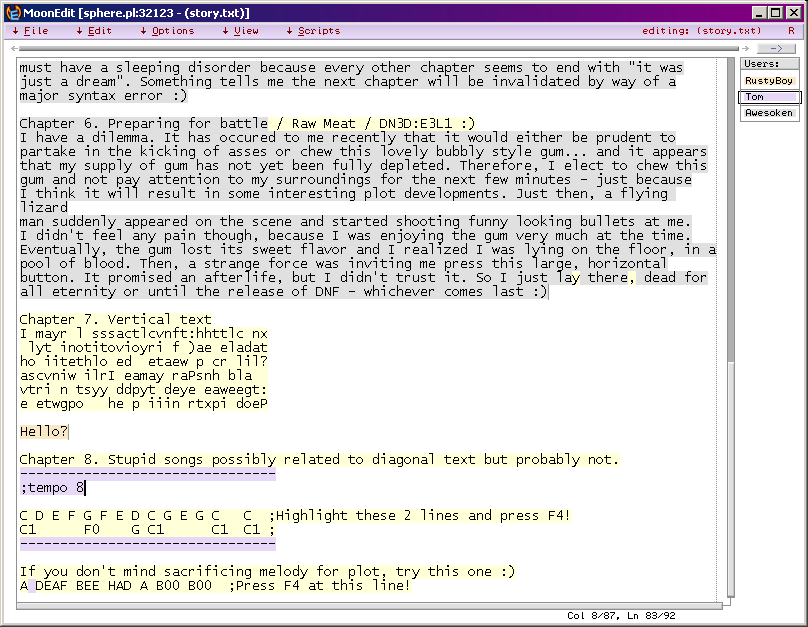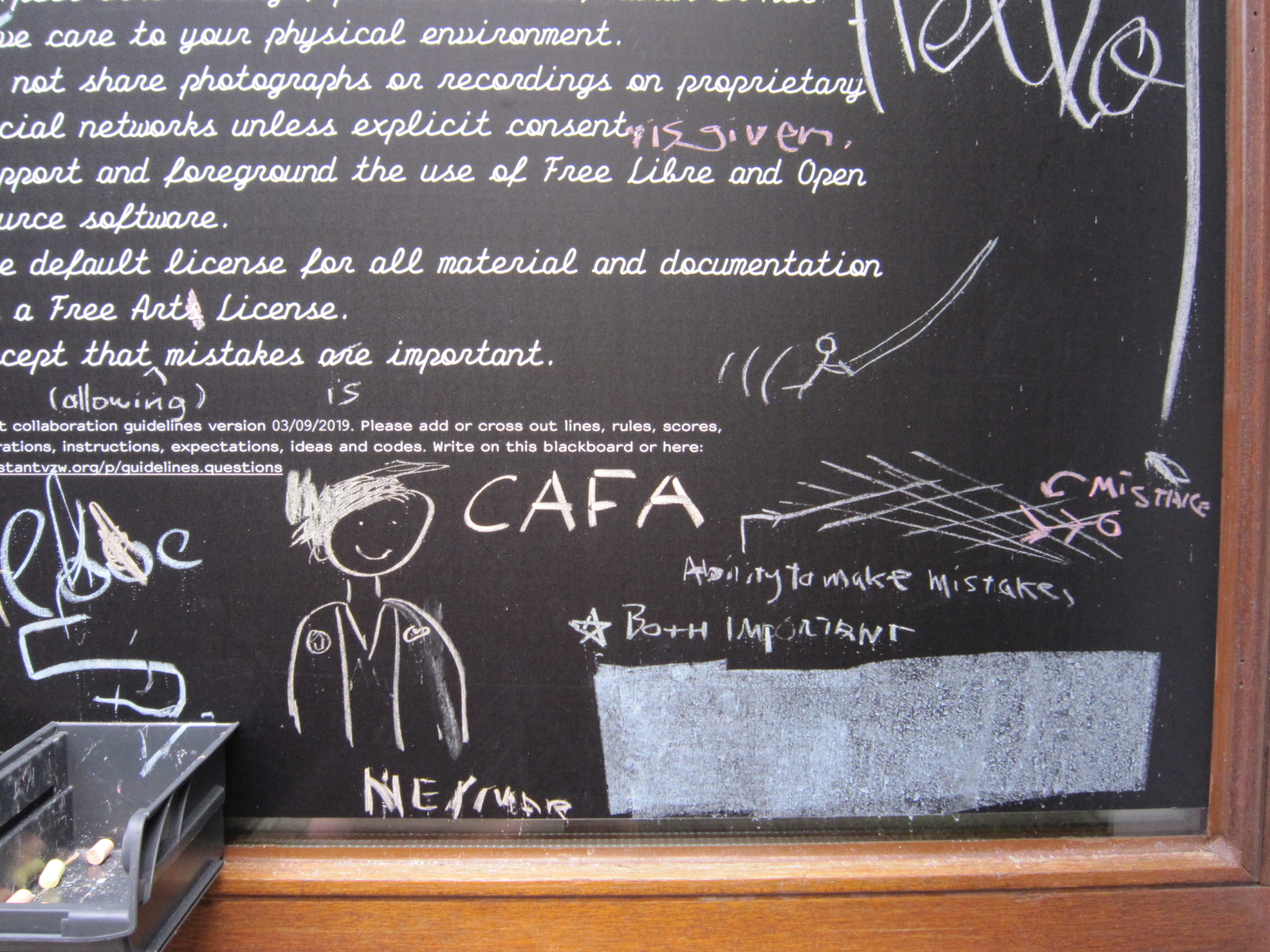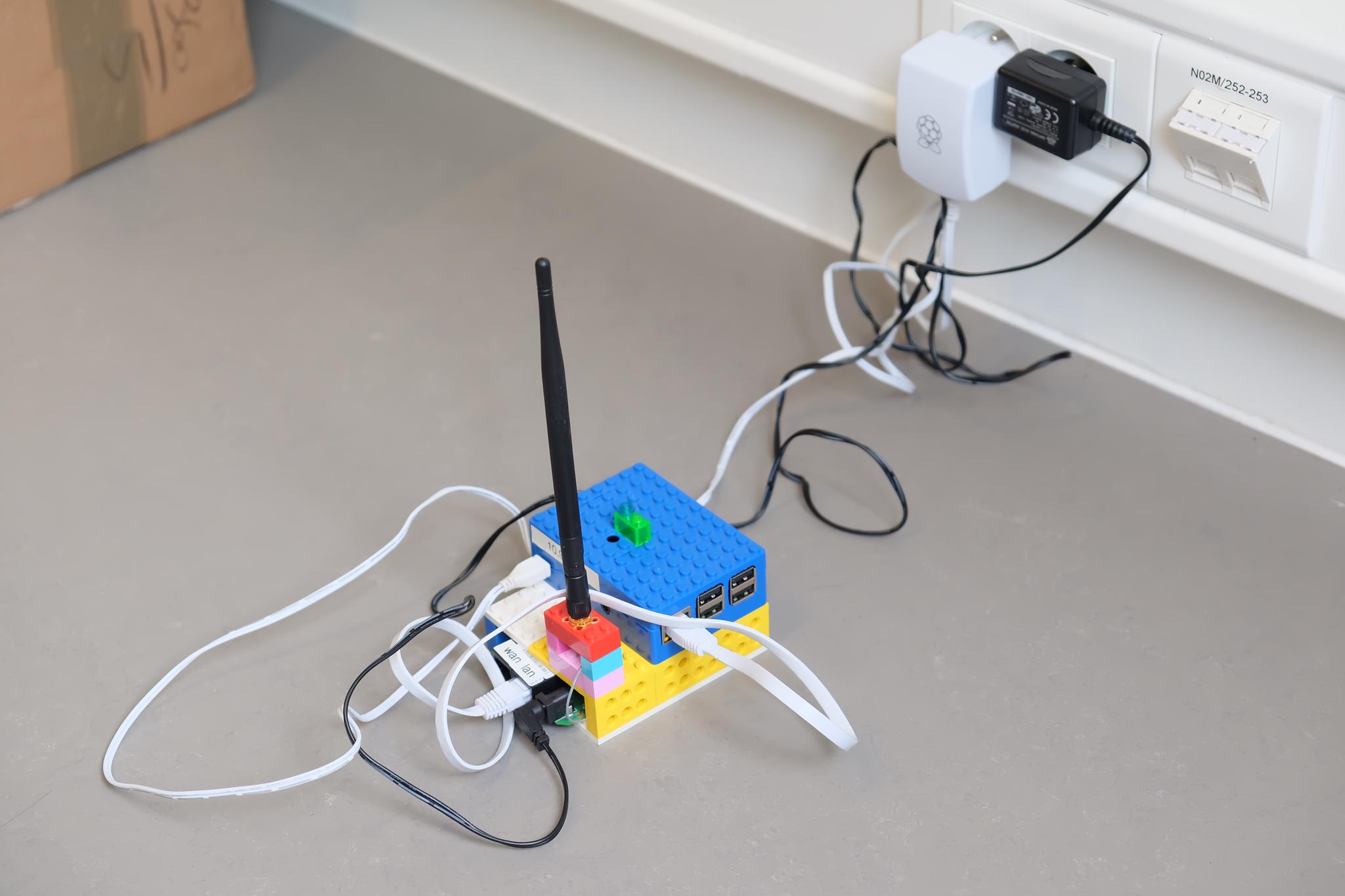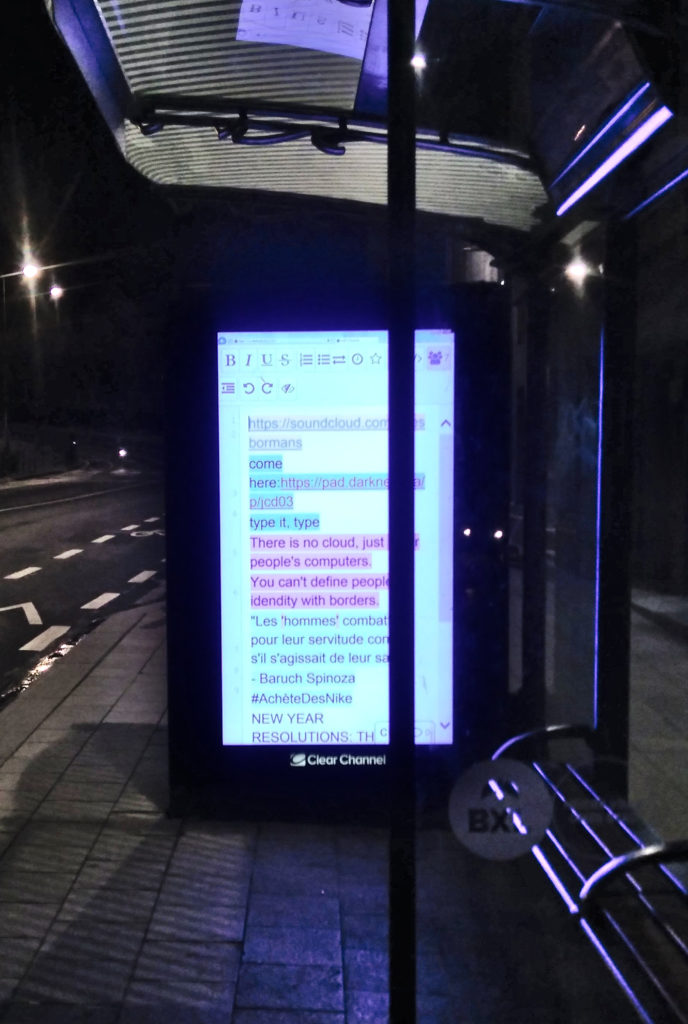Constant Padology
Martino Morandi
January 2023
Tools shape practice shapes tools1
At Constant, there is one piece of software that is nearly omnipresent across our work, whether for administration, the organization and development of projects, documentation tasks, or the making of publications. As an association that tends to stick to the principle of having “at least more than one way to do things,” Etherpad is an exception to the rule. “Pads” have become central to the daily practice of Constant, and they are probably the one tool that would be difficult to substitute. (Feel free to try out the example above.)
A free and open-source collaborative live text editor, Etherpad combines the minimal comfort of plain-text writing with the collective experience of a writing surface shared with others, an experience animated by visually simultaneous writing. The author of the writing is identifiable through colors alone; usernames are optional and text can be made anonymous (and common) by clearing the different colors of a portion of text.
Thanks to its simplicity of use and accessibility, it is a tool with a lot of potential for collective writing, note-taking in meetings, and keeping track of organizational tasks or links and loose pieces of text in shared research. In our association, it has also become deeply intertwined with our publishing efforts, mobilized for the coordination and planning of our publications and often used as an integral part of the publishing workflow.
Constant’s Etherpad-lite installation has been a technical companion for nearly ten years now, and it is a fundamental tool in our daily practices. The following essay is a brief listing of the aspects of the software that make it versatile in the different roles it fulfills, which altogether describe the type of chosen technological horizon that we try to foster in our practices.

MoonEdit, circa 2004 (Tom Dobrowolski)
Chosen Entanglements
The first example of a networked collaborative text editor using colors that was available for users to download and use on their personal computers is called MoonEdit. Released in 2003 by Tom Dobrowolski, it already contains most of the aesthetic and functional features and limitations that characterize Etherpad. But as often happens with open-source projects, the genealogy of Etherpad is more entangled with a seemingly similar but fundamentally different commercial doppelganger: Google Docs. Etherpad was first developed by former Google employees and then sold just one year later to the very same company, who merged the software with their own Google Wave project, then stopped it, and later revived it as part of the Google Docs suite. Fortunately, the source code of Etherpad was publicly released, and since then, the Etherpad Foundation has taken care of the project.
While it is often mentioned as a lighter and free Google Docs alternative, it is worth considering how Etherpad constitutes a different paradigm of online software and a radically different proposal of what it means to write collectively online. As account registration is neither necessary nor possible, there is no ownership of documents. The sole ground of recognition between users are their colors. Author colors are also not strictly individual: they can be removed, making the text everybody’s and nobody’s, or multiplied by just typing in different browser windows. There is no form of individual tracking in the system – neither by connecting the users to other platforms and services nor by studying behaviors to extract profitable information for advertisers. That helps keep the software light in terms of downloaded data, server resources, and load on the processor of the user’s computer.
From the limited point of view of energy consumption, it is possible that a corporate cloud service such as Google Docs still performs better: Alphabet prides itself on extremely energy-efficient data centers and actively pitches the doctrine that moving to cloud-based platforms reduces energy consumption per user. Alas, this coincides with tracking users’ activities and inducing them to consume more, as the data-extraction schemes of the company need users to keep connected to their services as much as possible. Not to mention that this new “environmental” face of Alphabet is just about improving efficiency – it is never allowed to threaten profits.2
Carbon efficiency is a very limited factor to consider in the general ecology of one’s tool involvements. At Constant, we try to consider many other less quantifiable facets, a quest that, when taken seriously, is never-ending. This complexity, though, is not lived as the contrition to try and be as correct as possible, but rather as the engaging process of realizing and choosing our own dependencies and involvements. We deepen our reliance on the tools that have fruitful influences on our practice; we conspire together on how to take distance from corporate platforms that stand for the capture and impoverishment of relations. Most importantly, this continuous process is a common one, as we are accompanied by many comrades and friends that share the urge to rethink our digital involvements.3
Organization-in-action-into-words
The questions of collective writing and the struggle with authorship are probably as old as writing itself, and the disruptive, creative, and political potential of dissolving, subverting, and blurring the position of the author has been explored thematically, from the avant-gardes on. Moreover, as Sara Ahmed illustrates in Differences That Matter (1999), a “feminist approach to women’s writing takes us beyond the opposition between the author as living (modern) and the author as dead (postmodern).” The author has died and come back, “is in-between life and death,” with the renewed understanding that who is writing does matter, finally rid of the illusion of a creator in isolation.4
While all this was happening, academic publishing did not take notice: the modes of writing where authorship is fuzzy are still forbidden in academia. The habit to assign merit to individual authors is so immutable that even an article about collective writing will be conveniently chopped into well-defined individual contributions.5
The most common type of writing that appears on Constant’s Etherpad installation, though, would probably be better described by another written space, a sort of organizational writing. In the text “Writing and (Re)writing Devices as Tools for Managing Complexity,” Michel Callon describes a similar form of collective writing by looking at two firms that changed and re-edited their manuals with custom writing devices. I was stunned by his description of how “writing devices that put organization-in-action into words are the product of a collective effort that involves conflict and leads to intense negotiation; and such collective work is never concluded, for writing leads to endless rewriting.”6
It is maybe such organization-in-action-into-words, the strange type of writing that takes place on a daily basis on Etherpads, when we sketch articles for the Constant website, redact open calls, draft administrative reports, and outline funding applications. This description of a never-concluded collective work perhaps applies the most in the Constant Collaboration Guidelines that accompany Constant’s public activities. The guidelines express our approach to the question of codes, conduct, and care for collective situations, and the document has regularly been rewritten and renegotiated within the team and in conversations with participants of worksessions and workshops. This slowly evolving piece of text shows how, unlike the corporate writing devices that Callon describes, it is not so much the management of complexity, but rather its consistency or even intensification, that the Etherpad writing device brings to Constant’s work.7

First release of the Collaboration Guidelines: Constant’s vitrine turned into a blackboard, 2019 (Femke Snelting)
Padology
The increasing reliance of projects and internal organization on Constant’s Etherpad installation soon gave rise to some issues to deal with. First of all, the ease of making a new pad could make things get slightly out of hand: in larger projects, multiple sub-pads for different facets and phases would become a series of nested pads linking to each other, a sort of termite nest under the surface of the pad installation. This, of course, makes it increasingly difficult to remember the actual page on which something was mentioned or worked on. Listing all pages in yet another pad was definitely not a solution!
Related issues, the growing amount of pages, and increased usage also made the system unstable at times, and server issues meant not being able to access the content of needed notes. This resulted in etherdump, a tool developed by our colleague Michael Murtaugh, which doubles as an organizational database of all public pads as well as a system to make static copies of the pages. With etherdump, if the Etherpad server is down, the text content of the pages will still be accessible in plain text or html.
This could have interfered with the privacy policy of the default version of Etherpad-lite: the index of all pages on the server is usually only available to administrators, and it is important for users to be able to keep pads private. To allow a degree of chosen visibility, then, etherdump includes a function to add or remove a page from the public index based on the presence or absence of the magic word __NOPUBLISH__.
Constant’s physical spaces did not escape the influence of pads either: as part of our practice of making network infrastructure materially present in collective work situations, we have experimented with local area setups to support pad-writing in the case of larger groups of people or clogged internet connections. The result is a local and portable version of Etherpad that can run on a pocket-sized computer that creates a local wireless network without the need for an internet connection. The setup, dubbed etherbox, has become a regular presence in Constant’s worksessions, bringing the server into the room as a physical object and writing system, a machine that can be moved around and connected to.

Etherbox in its “blox” version, 2018 (Peter Westenberg)
Can you make a book with it?
Whether in the planning phase, in tracing discussions and workshops, or in the documentation phase, most projects at Constant involve one or more pads, and this comes by now as a sort of reflex. Sometimes, instead, it is a programmed and conscious choice to start employing pads for a specific use. That is the case for publishing processes. While in everyday use, a shared text file is as basic a technical habitude as opening a spreadsheet to redact a budget, choosing to include it in a publication pipeline is a more daring choice that influences the whole publishing process. When you choose to use a tool that is not designed with a certain application in mind, you consciously go for a misuse that will make workarounds and self-cooked solutions necessary. As part of an exploration of the relation between tools and practices, we have often chosen to do so, using pads to process and typeset texts to produce a printable format.
Unlike proprietary “industry-standard” options such as the Adobe Suite, Etherpad-lite allows us to work collectively on the textual content of the pages, in parallel to design work. Plain text is fundamental as it allows us to apply style sheets in a programmatic manner, before, during, and after the editing of the texts. In general, this choice complexifies workflows and the traditional distribution of tasks, and that is never “easy.” Publishing with experimental pipelines means the collapse of the rigid separation between editorial work, design work, development, and infrastructure care. Copy-editors can work directly on the source-text materials for corrections; the role of caring for software and working on the visual layout happens in close collaboration.
Still, this is not about efficient flows and improved logistics. This type of setup also means the designer might struggle to obtain a certain imagined outcome, negotiating with browser styles to turn a webpage into a printable book. Or that the copy-editor might find out, in a last rereading, that some words have disappeared at the end of a column, and get in touch with the developer to solve the issue before sending the file to print. What helps, at the scale in which Constant works, is that these roles are often shared or overlapping, and always in communication.8
What do the results look like? Here’s a short list of publications realized at Constant, mobilizing Etherpad in different combinations: Are You Being Served? (2015), made with the Ethertoff setup developed by Open Source Publishing; Conversations (2015) and the Techno-Galactic Guide to Software Observation (2018) were outputs of the Etherpash tool developed by LAFKON; and the Iterations (2020) publication, made with a combination of Etherpad and Reportlab by Manetta Berends.
The list is bound to grow, and there seems to be no shortage of interesting projects that recombine this piece of software in different publishing pipelines. The first to come to mind for a shoutout are octomode by Varia and Pad2print by Luuse.
One day every screen will host its own pad
The versatility of a shared text surface that can be acted upon by multiple users at the same time has made Etherpad-lite a software that often gets embedded in other systems – at times visibly, at times more subtly. That can happen with structural inclusion in software platforms – for example, as it appears as a note-taking function with all colors removed in the video-streaming software BigBlueButton. Sometimes, instead, it is included to add an additional note-taking function in ad-hoc projects – for example, in the case of the SEMI-PAD, a merger of the e-book organization software Calibre and Etherpad-lite, in order to be able to do collective readings with comments.
Other times, Etherpad is included in websites or projects to expose the content to modification by the users. The boldest version of that approach is perhaps the website of the PUSCII collective in Utrecht, which uses the collective writing sheet as a home page, a sort of daring reversal of website branding and of the security imperatives of today’s web.
In an even more promiscuous use, the very same online notepads have sometimes been employed in the hacking of embedded devices and computers in public space, as a technique to make a temporary collective subversion of who can write on those publicly exposed screens. For example, in 2020, dozens of advertising video screens in the streets of Brussels were turned into public writing boards for some hours and ended up filled with a strange mix of political slogans, poetic lines, bad jokes, and SoundCloud links.9

Etherpads in the streets of Brussels, 2020 (Indymedia Bruxsel)
Safely Nonsecure
Collectively sharing this mode of writing in situations where the tool was not already known raised, at times, the question of the security of such a medium. The low threshold of entrance and high degree of anonymity could seem a vulnerability exposing the live texts to possible verbal abuse, defacements, and disruptions. On the contrary, out of the situated experience of using various Etherpad installations, being responsible for two, and knowing many peers administering another half dozen, I have witnessed an incredibly low amount of disruptions and trolling – in fact, hardly any that were malicious or fatal. The most annoying situations have been when a pad gets completely erased (in most cases by one of the writers, by mistake), but even in those cases, the timeline allows the user to retrieve the complete text version before erasure.
There is a reason for this experience of safety of Etherpad installations and similar small and decentralized systems, and it is rooted in the proposal of a different type of usership in contrast with the one produced on massive corporate platforms. The most important difference is that at the scale in which you can trust the collective or the group that runs a decentralized service, you can count on the fact that an eventual abuse will be dealt with by the whole community, and not just an individual and the department specialized in such incidents.
While commercial platforms propose the feeling of being in a public space, they are instead linking all content to trackable users who must be “engaged.” Pads are publically accessible (albeit hard to find) and are not individually owned or linked to a private account. This sets up another topology of trust and responsibility.10
While the type of security-by-design proposed by corporations is just a technical solution that shifts the problem elsewhere, in small-scale systems, a safer online space is created by the trust that when abuse takes place, it will be dealt with as a central issue threatening a whole community, instead of just another threat to revenues and shareholder’s profits. Trust and safety will not come from technical security alone; they also come from the language in use, how someone starts using a system, and the suggested mode of relating to each other in shared spaces.
Networked Interdependency
A last subtle thing we got to appreciate in the setups described in this text is how, in the mutual sharing of resources, one can have a glimpse of the heterogeneous network of personal and organizational interdependencies of an association like Constant. In a different way to how making publications together and sharing similar softwares creates networks with people, sharing the Etherpad also creates a network: during workshops or collective activities, when we introduce it as the tool we write with, some of the participants acquire https://pad.constantvzw.org as a new reference in their toolbox. If they do not already know an Etherpad instance (a specific installation of the software) they trust, they often start using it regularly for their own activities – something we fully encourage. Meaningful uses of the tool and newly acquired habits build a subtle web that represents a network of distributed, sedimented trust. The documents appearing on the etherdump timeline are a very discreet reminder of those systems of socio-technical interdependencies. Reading this list reminds us of the groups and collectives we have met in different convivial situations and moments and encounters in which collaborative writing took place. The list shows the many companions, collaborations, and communities that use pads on Constant’s server, in situations outside of our work. Connections arise through the collective practice of writing and through the distributed running of the infrastructure that supports it.
Copyleft 2023 Martino Morandi. You may copy, distribute, and modify this material according to the terms of the Collective Conditions for Re-Use (CC4r) 1.0.
Footnotes
- The motto of open-source publishing is a dear reminder of the iterative and reproductive relation that ties together means and ends.
- Google keeps providing its services to fossil fuel companies for billions of dollars, to improve and intensify surveying and extraction. For more information, see “Tech Titans Google, Microsoft, Amazon Help Fossils Extract More Oil and Gas at Less Cost,” The Energy Mix, February 25, 2019.
- Two resources offering a rich collection of theories, practices and terminologies that have greatly informed and inspired Constant’s work on digital ecologies are the Damaged Earth Catalog (compiled by Marloes de Valk) and the Permacomputing wiki.
- Sara Ahmed, Differences That Matter: Feminist Theory and Postmodernism (Cambridge, UK: Cambridge University Press, 1999), 134.
- See, as an example, Sonja Arndt, Rachel Buchanan, Andrew Gibbons, Ruyu Hung, Andrew Madjar, Rene Novak, Janet Orchard, Michael A. Peters, Sean Sturm, Marek Tesar, and Nina Hood, “Collective Writing: Introspective Reflections on Current Experience,” Educational Philosophy and Theory 54, no. 9 (September 2020): 1296–1306.
- Michel Callon, “Writing and (Re)writing Devices as Tools for Managing Complexity,” in Complexities, ed. John Law and Annemarie Mol (Durham, NC: Duke University Press, 2002), 203.
- For more on Constant’s collaboration guidelines and other approaches to collective publishing, see Mia Melvær’s “A Reparative Approach to Publishing,” MARCH: a journal of art & strategy, April 2022.
- For more reading on the joys and sorrows of unconventional publishing pipelines, see Manetta Berends, “The So-called Lookalike,” in Volumetric Regimes, ed. Jara Rocha and Femke Snelting (London: Open Humanities Press, 2022).
- More information about this Etherpad action against advertising can be found at: https://bxl.indymedia.org/Sur-la-profanation-d-une-quarantaine-d-ecrans-publicitaires-a-Bruxelles.
- For more on trust and computing, see Sarah Friend’s “Beyond Follows: Trust in Computing,” MARCH: a journal of art & strategy, May 2022.
Martino Morandi maintains a recalcitrant relation to bio-texts and other technologies that produce predetermined subjectivities. He is an interdependent researcher at Constant in Brussels, Infrastructural Manoeuvres in Amsterdam, and C.I.R.C.E. (International Resource Center for Electric Convivialities) in Italy. Ongoing projects include studying surveyance and the quantified gaze over contemporary cities (Footfall Almanac with Alex Zakkas) and seeking strategies to resist the computational reform of education (The Relearning Series with Jara Rocha).